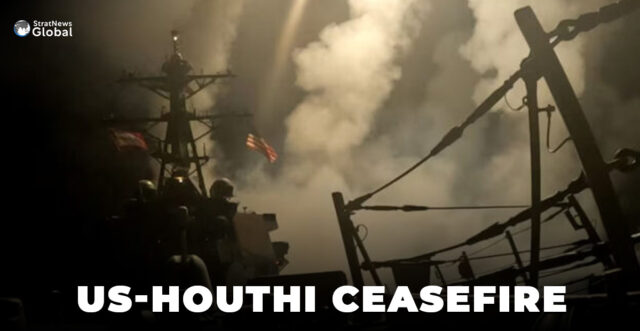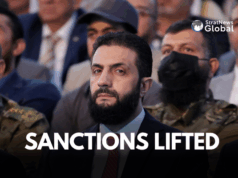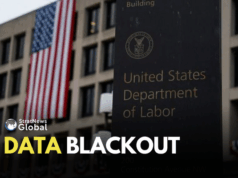Just days before the US unexpectedly reached a ceasefire agreement with the Houthis, American intelligence began detecting signs that the Yemeni fighters were seeking a way out after enduring seven weeks of sustained US airstrikes, according to four American officials.
Houthi leaders began reaching out sometime around the first weekend in May to US allies in the Middle East, two of the officials said.
‘Houthis Had Had Enough’
“We started getting intel that the Houthis had had enough,” one of the sources said, speaking on condition of anonymity to recount the internal discussions about the intelligence, which haven’t been previously reported.
The US abruptly ended its military campaign against the Houthis on May 6 after 52 days, despite initially planning for it to last much longer. This allowed President Trump to declare a timely victory ahead of his Middle East trip.
The Houthis had been attacking Red Sea shipping since November 2023 in support of Palestinians. Iran, which supports the Houthis, reportedly played a key role in pushing them toward negotiations, as Tehran seeks progress in its nuclear talks with the US to ease sanctions and avoid potential military conflict.
The ceasefire deal highlighted how swiftly the Trump administration acted on early intelligence to achieve what had seemed unlikely just weeks earlier: a Houthi pledge to stop targeting US ships.
Trump’s unorthodox strategy included excluding and not informing Israel — despite being a key US ally — which is not part of the agreement, according to sources.
The Houthis weren’t the only ones feeling pressure. The bombing campaign has also been costly to the United States, which has burned through munitions and lost two aircraft and multiple drones.
Window Of Opportunity
After receiving intelligence in early May, US Defense Secretary Pete Hegseth led White House meetings and identified a chance to reach a deal with the Houthis.
Trump’s Middle East envoy, Steve Witkoff, used Omani mediators to conduct indirect talks with Houthi negotiator Mohammed Abdulsalam, who was in contact with the group’s top leader, Abdul Malik al-Houthi.
A framework agreement was reached that Monday, and by Tuesday, May 6, Trump announced the deal, claiming the Houthis had capitulated.
“They said please don’t bomb us anymore and we’re not going to attack your ships,” he told reporters.
Asked about Reuters’ findings, the Houthis’ Abdulsalam said the group communicated only via Oman and agreed to the ceasefire because the Houthis had been responding to the United States defensively.
“So if they stopped their aggression, we stopped our response,” Abdusalam told Reuters, declining further comment.
A spokesperson for Witkoff did not immediately respond to a request for comment.
Off-Ramp
Both sides saw advantages in reaching a ceasefire.
For the Houthis, it provided a chance to regroup and avoid long-term strategic risks from continued US pressure. Regional US allies also supported a deal to avoid becoming Houthi targets if the conflict escalated.
Initially, Houthi leader Abdul Malik al-Houthi vowed to keep attacking US ships, and a prolonged, costly standoff seemed likely as the US launched over 1,100 strikes.
Defense Secretary Hegseth maintained the bombings would continue until the Houthis stopped targeting U.S. assets.
The Houthis shot down seven US MQ-9 drones — each worth tens of millions of dollars — since Trump took office.
The Harry S. Truman aircraft carrier, whose deployment in the Middle East was extended by Hegseth, lost two fighter jets, including one falling from the deck of the ship after the massive vessel was forced to make a hard turn because of a Houthi attack in the area.
Ability To Bounce Back
Some analysts questioned the US strategy, noting the Houthis had previously survived years of Saudi-led strikes and still regained enough strength to threaten the US Navy and Israel.
A key turning point came on April 17, when the US launched its deadliest strike yet on the Houthi-controlled Ras Isa fuel terminal, killing 74 people according to the Houthi-run Health Ministry. The Pentagon has not confirmed casualty figures.
“That (damaged) their ability to conduct operations and generate revenue,” the official said, describing efforts to squeeze the group economically.
Asked for comment, White House Deputy Press Secretary Anna Kelly told Reuters Trump’s ceasefire was “another good deal for America and our security.”
“The objective at the outset was securing the freedom of navigation, and that was achieved through the restoration of American deterrence.”
Pentagon spokesperson Marine Colonel Chris Devine said in response to Reuters’ findings that the US military campaign successfully degraded Houthi capabilities and “set the stage for the President to achieve a ceasefire agreement.”
Longer Campaigned Proposed
Trump launched a campaign against the Houthis after the Biden administration’s efforts to deter the group failed.
US Central Command had recommended an eight-month operation, shifting from broad to more targeted strikes. The campaign, costing over $1 billion, killed many mid-level Houthi fighters and destroyed key infrastructure, including command centers, weapons facilities, and missile stockpiles.
However, it failed to disrupt supply lines or weaken top leadership. Experts warn the Houthis could quickly recover, and their continued attacks on Israel after the May 6 ceasefire show they still have significant capabilities.
US officials and other sources also caution that it is unclear how long the ceasefire will hold, and if the Houthis will continue to see the United States and Israel as separate threats, especially as Israel retaliates against Yemen.
“Proxies of Iran and Iran don’t distinguish between what is Israel and what is the United States,” one person familiar with the situation said.
“Their view is that anything Israel does is enabled by the United States. So at some point, I think the Houthis will see themselves as trying to hold the United States accountable.”
(With inputs from Reuters)





